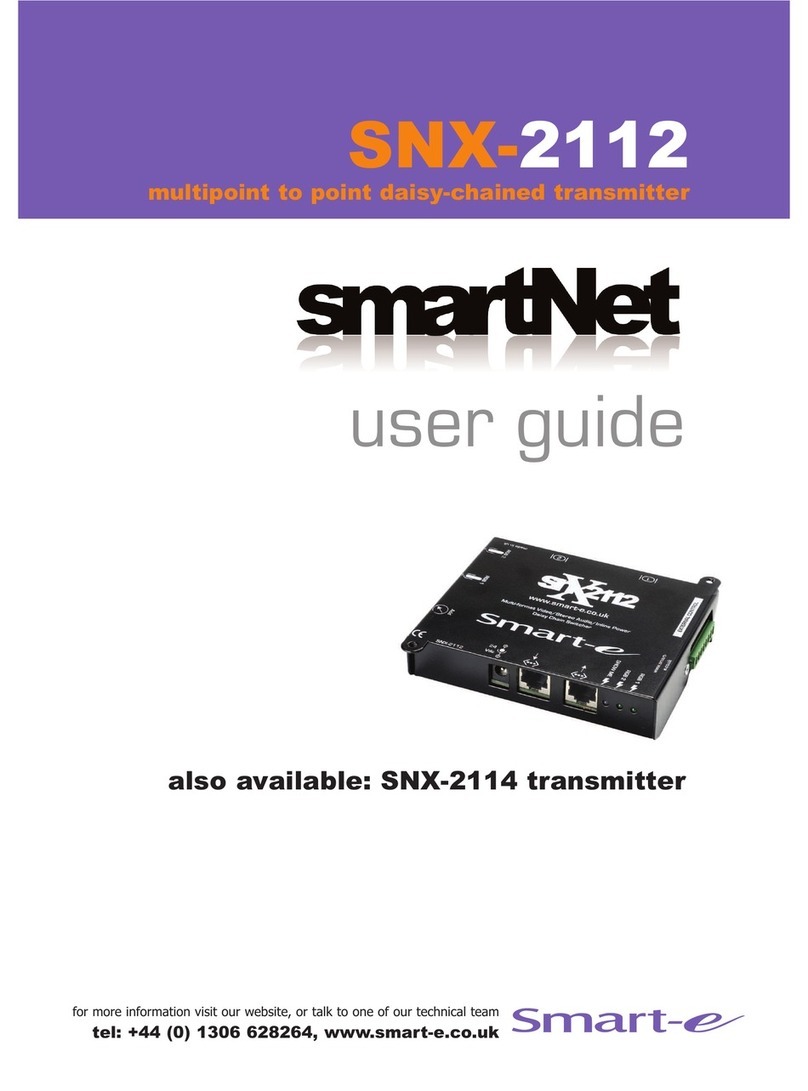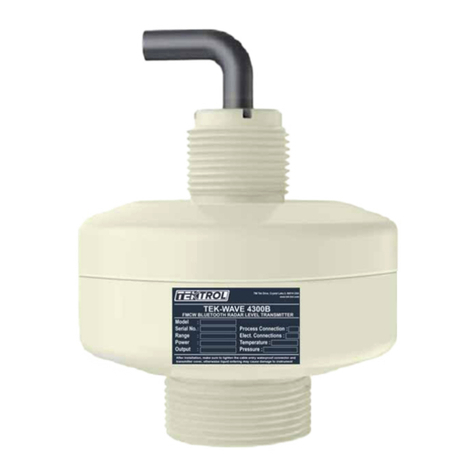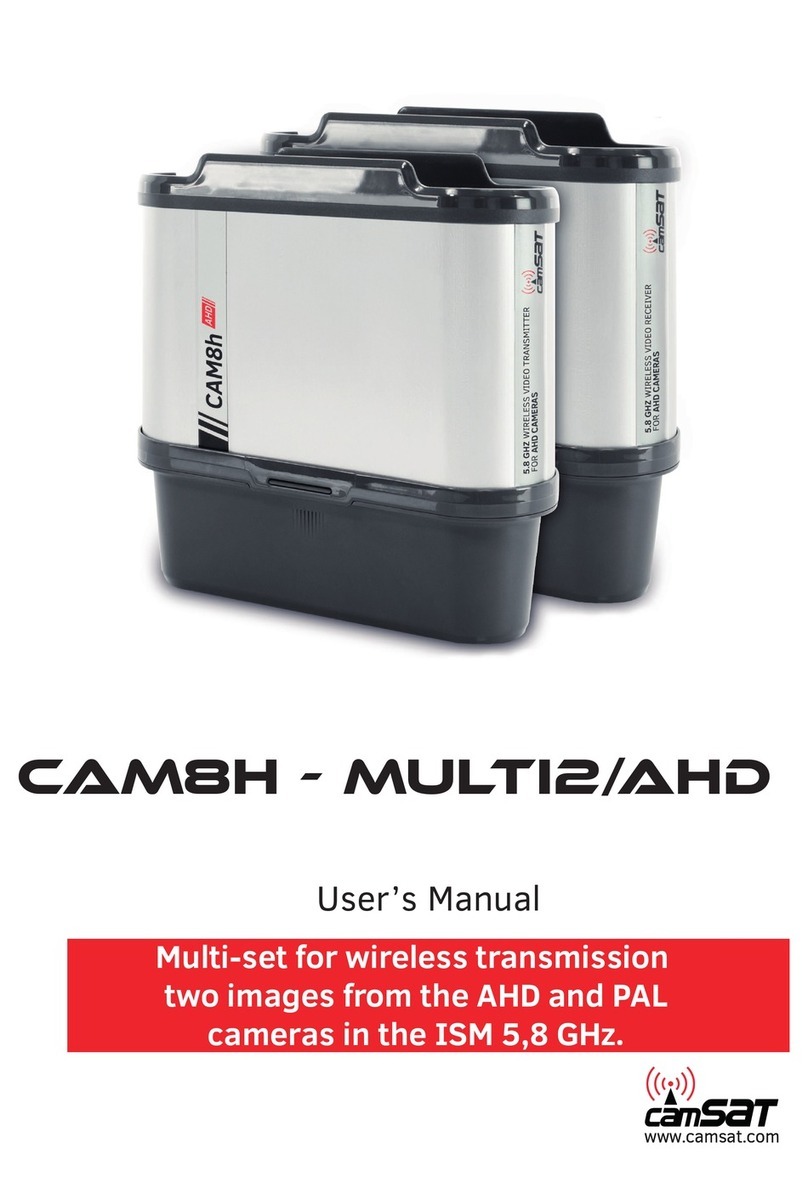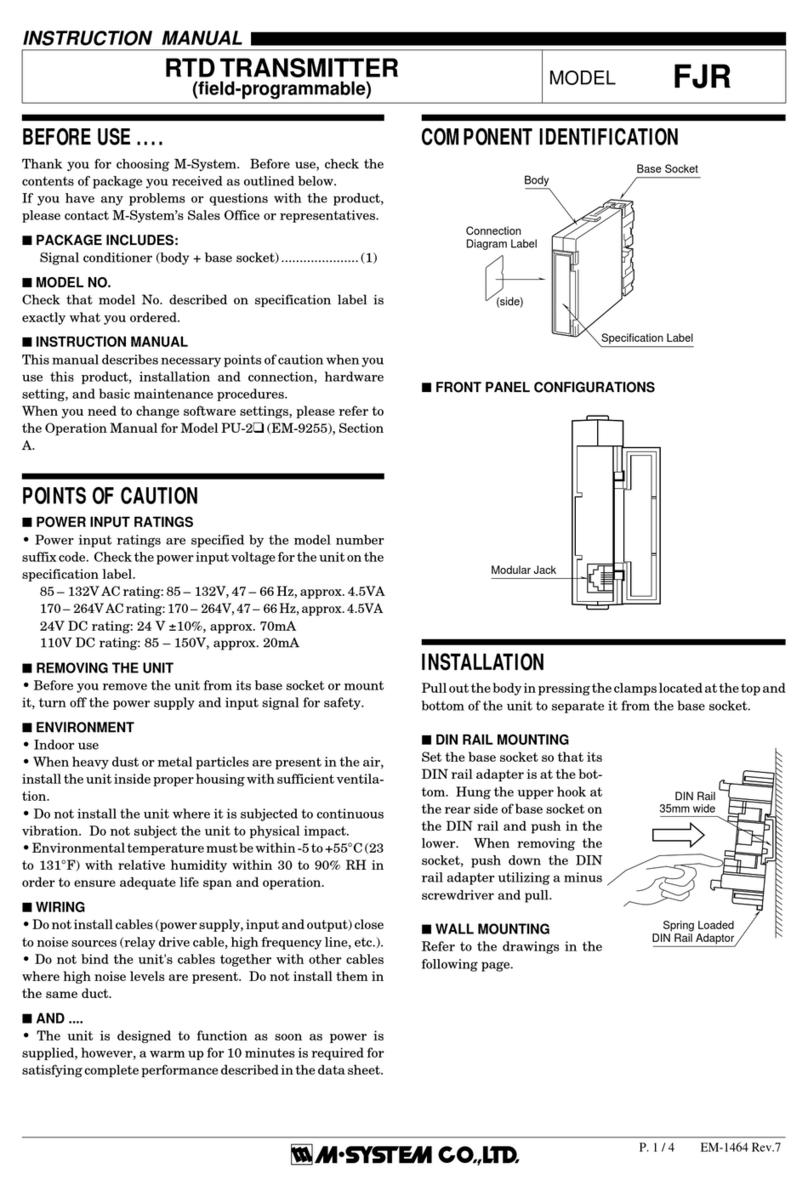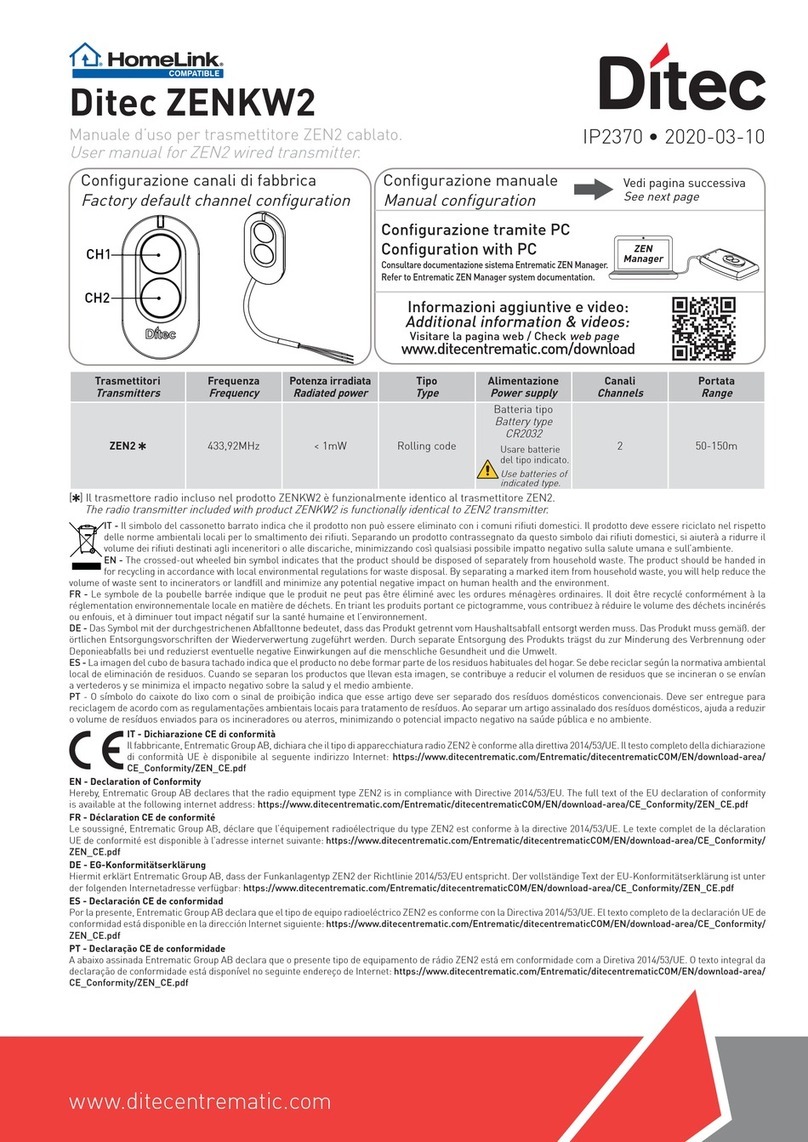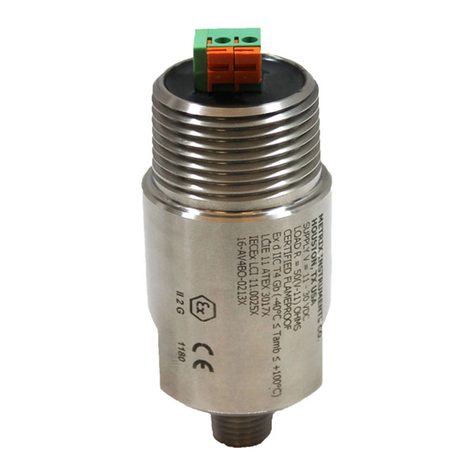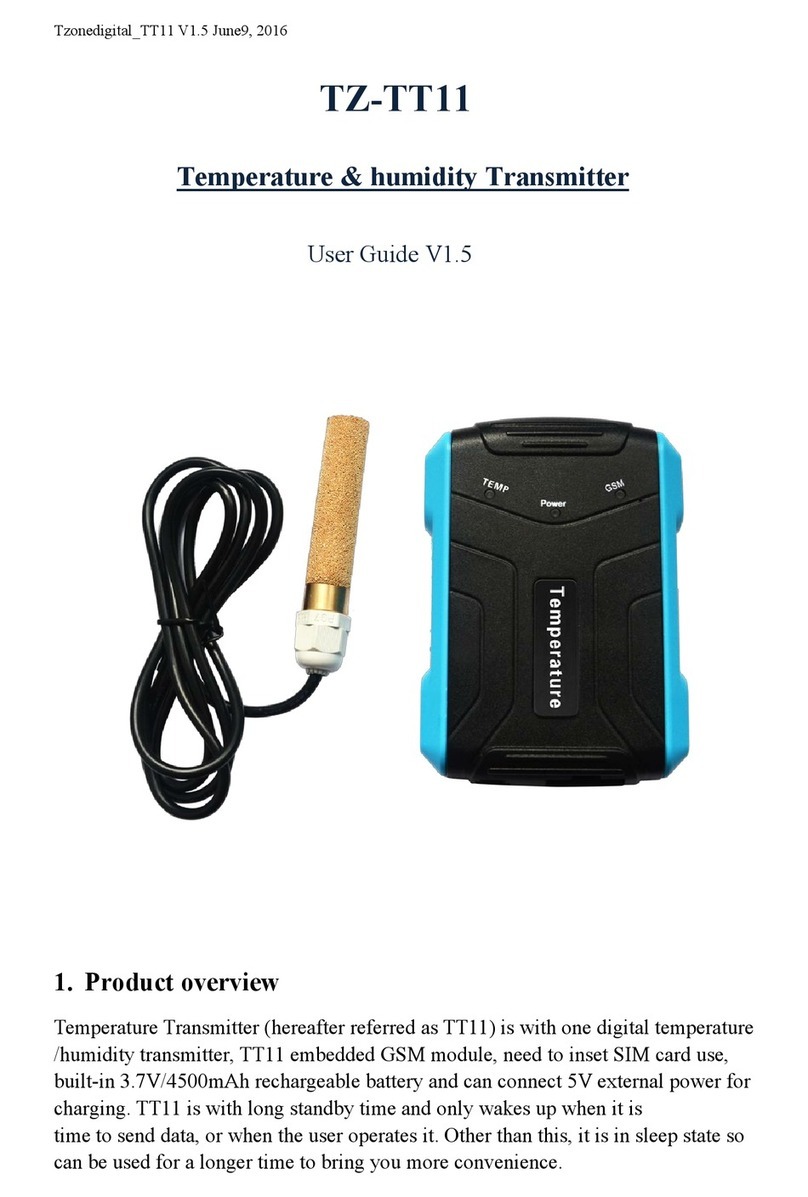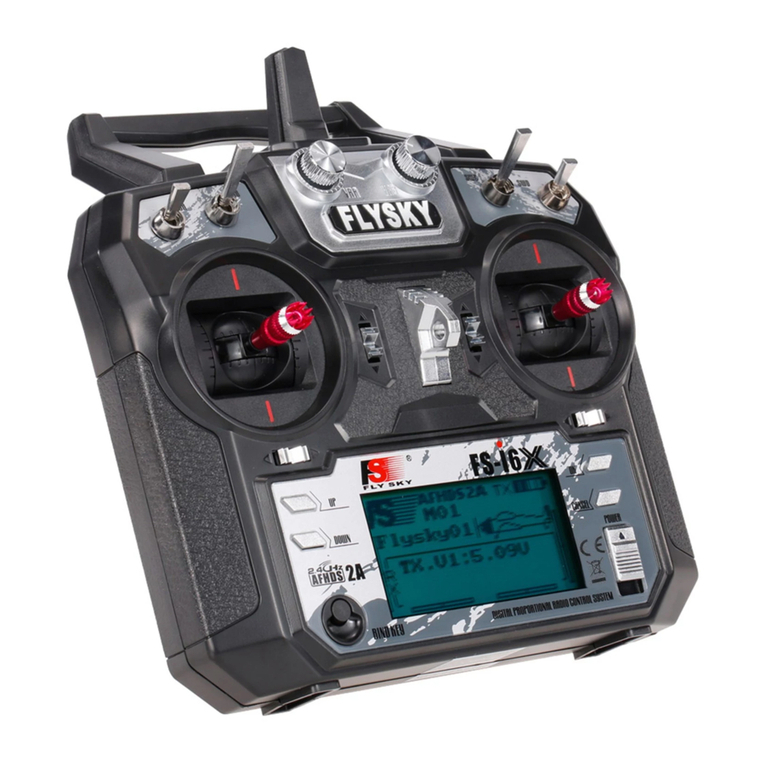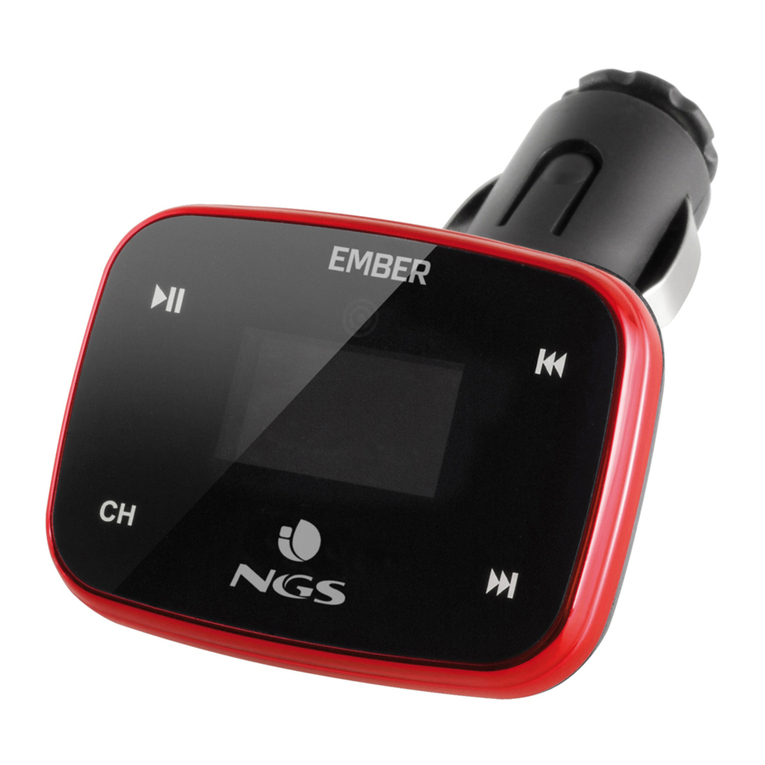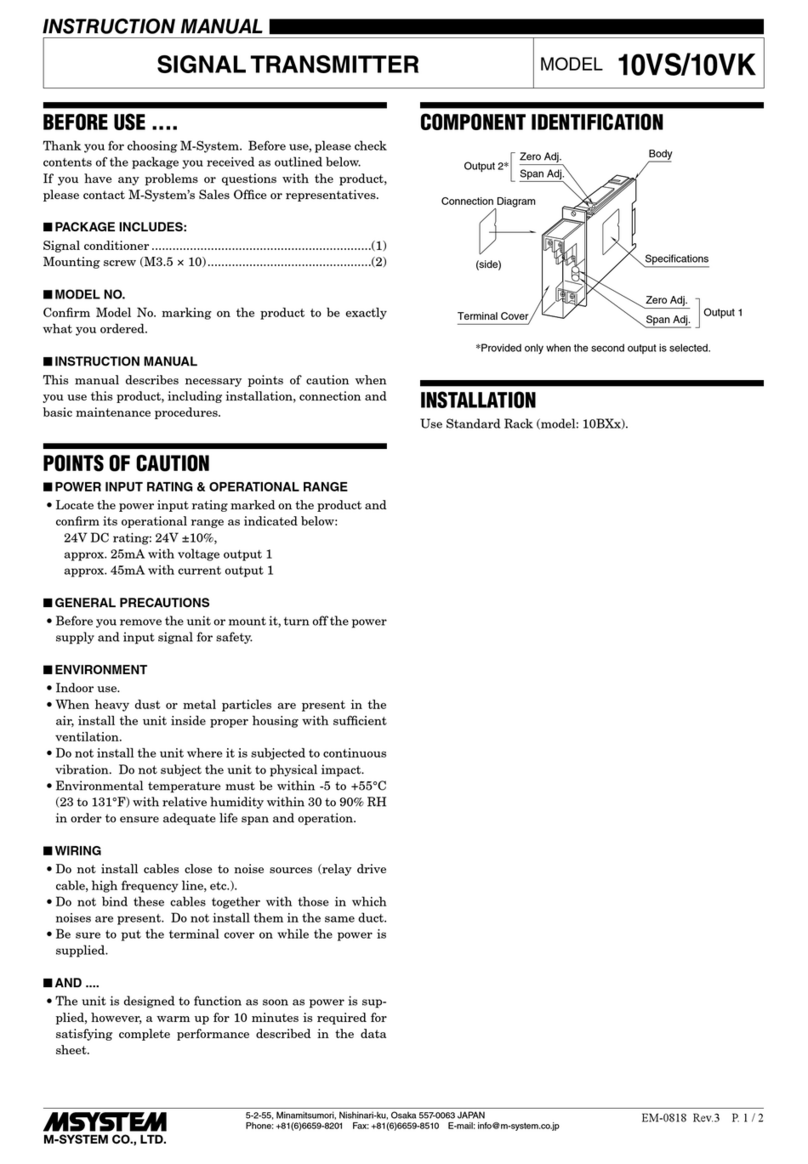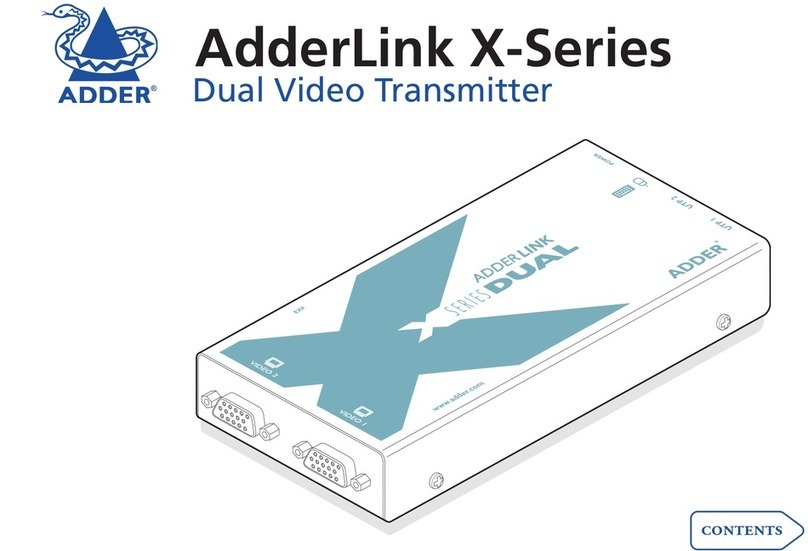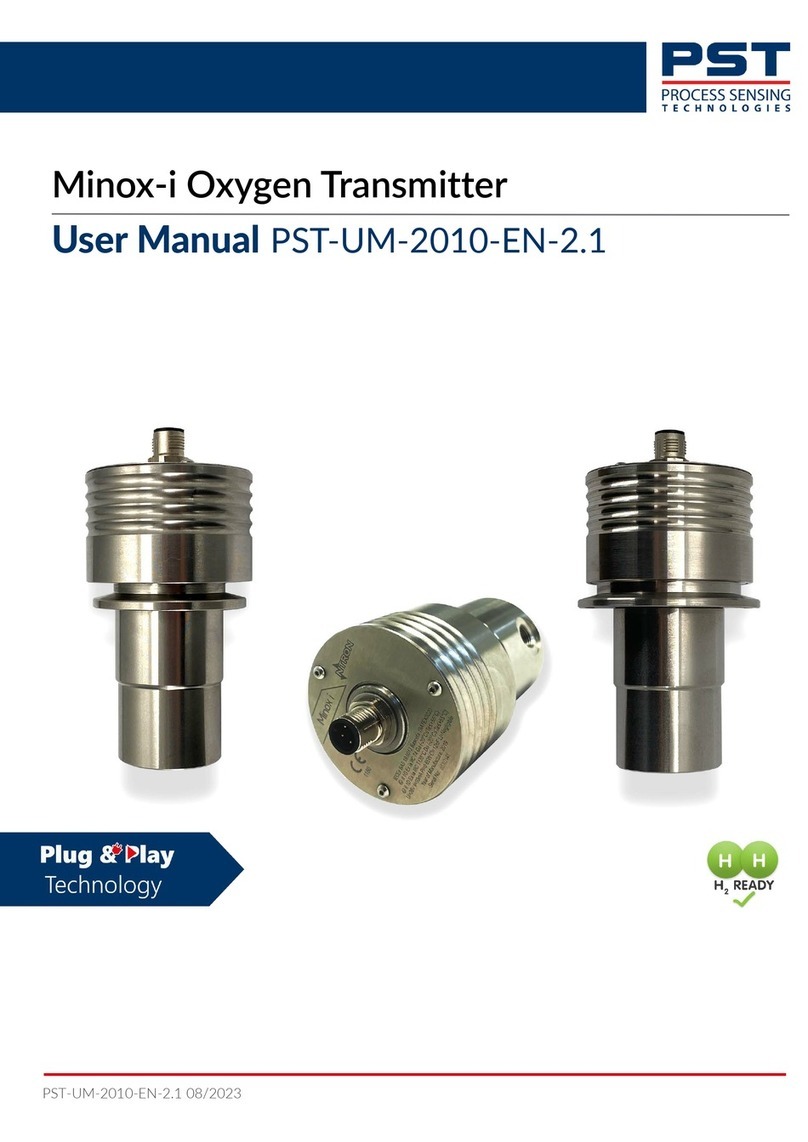EMERGENCY BEACON CORPORATION EBC-406HM Instructions for use

BE SURE TO REGISTER
THIS ELT
EBC-406HM
EMERGENCY LOCATOR TRANSMITTER
INSTRUCTION AND MAINTENANCE MANUAL
EMERGENCY BEACON CORPORATION
461 TIMPSON PLACE
BRONX, NY 10455
PHONE (718) 401-0288
FAX (718) 401-0663
Web: www.emergencybeaconcorp.com
July 2022
Rev. 8

EMERGENCY BEACON CORPORATION
July 2022, Rev 8
THIS PAGE LEFT BLANK

EMERGENCY BEACON CORPORATION
July 2022, Rev 8
TABLE OF CONTENTS
SECTION 1 ................................................................................................................................................................................................... 2
GENERAL DESCRIPTION ....................................................................................................................................................................... 2
SECTION 2 ................................................................................................................................................................................................... 2
REGISTERING YOUR ELT ...................................................................................................................................................................... 2
SECTION 3 ................................................................................................................................................................................................... 2
TOGGLE SWITCH FUNCTIONS.............................................................................................................................................................. 2
SECTION 4 ................................................................................................................................................................................................... 3
ELT INSTALLATION................................................................................................................................................................................. 3
SECTION 5 ................................................................................................................................................................................................... 3
FINAL INSTALLATION ............................................................................................................................................................................. 3
SECTION 6 ................................................................................................................................................................................................... 3
TESTING THE ELT ................................................................................................................................................................................... 3
SECTION 7 ................................................................................................................................................................................................... 4
DESCRIPTION OF SELF-TEST MODE AND ERROR CODES............................................................................................................... 4
SECTION 8 ................................................................................................................................................................................................... 5
OPERATING INSTRUCTIONS................................................................................................................................................................. 5
SECTION 9 ................................................................................................................................................................................................... 5
PERIODIC INSPECTIONS ....................................................................................................................................................................... 5
SECTION 10 ................................................................................................................................................................................................. 5
EQUIPMENT LIMITATIONS ..................................................................................................................................................................... 5
SECTION 11 ................................................................................................................................................................................................. 5
BATTERY REPLACEMENT ..................................................................................................................................................................... 5
SECTION 12 ................................................................................................................................................................................................. 6
REPAIRS .................................................................................................................................................................................................. 6
SECTION 13 ................................................................................................................................................................................................. 6
EBC-406HM SPECIFICATIONS............................................................................................................................................................... 6
National Stock Numbers for the EBC-406HM Emergency Locator Transmitter:........................................................................................... 6
FIGURE 1: EBC-406HM ELT WITH BB-12M BRACKET OUTLINE WITH HOLE PATTERN ...................................................................... 7
FIGURE 2: EBC-406HM ELT WITH BB-15M TRAY OUTLINE WITH HOLE PATTERN.............................................................................. 7
GS-46 ENVIRONMENTAL QUALIFICATION FORM.................................................................................................................................... 8
EBC-406HM ENVIRONMENTAL QUALIFICATION FORM .......................................................................................................................... 8
EBC-406HM TWO YEAR WARRANTY ........................................................................................................................................................9
PLEASE READ - IMPORTANT! PLEASE READ - IMPORTANT! PLEASE READ - IMPORTANT!
WHEN USING IN AN EMERGENCY, REMOVE THE ELT FROM ITS MOUNT, EXIT AIRCRAFT, AND SET
TOGGLE SWITCH TO THE “ON” POSITION. THE ELT’S LED SHOULD BE BLINKING.
TESTING SHOULD NOT BE DONE WITH NIGHT-VISION GOGGLES. DO TEST BEFORE START-UP!
A “3 CODE” IS COMMON WHEN TESTING WITH THE TAPE ANTENNA. THIS CAN LEAD TO AN
AMBIGUOUS INTERPRETATION OF HOMER POWER. SECTION 6 DESCRIBES TEST PROCEDURES TO
ELIMINATE THIS AMBIGUITY.
CERTAIN INSTALLATIONS WILL GENERATE A “4 CODE” (BAD 406 MHZ VSWR). VERIFY THAT THE
ANTENNA IS WORKING BY REMOVING ELT FROM ITS MOUNT, AND RE-DOING THE SELF-TEST.
DURING NORMAL USE, KEEP THE 15-PIN D-SUB CONNECTOR DRY, AND FREE OF CONTAMINATION.
WHEN INSTALLING THE BB-12M, USE THREE MOUNTING SCREWS. USE HOLE PATTERN A OR B. REFER
TO PAGE 7. THE BB-15M REQUIRES FOUR MOUNTING SCREWS.
1

SECTION 1
GENERAL DESCRIPTION
The EBC-406HM is an Emergency Locator Transmitter (ELT)
designed for military helicopter installation. It meets the requirements
of TSO-C126 in the Automatic Portable (AP) category (see Figures 1
& 2). It is designed for mounting in the cabin of the aircraft, within reach
of the pilot or co-pilot. As with all EBC ELTs, the increased survivability
needs of cabin mounting have been met. The electronics and the
activation system are completely encapsulated, and extra protection
has been provided for the crystal. Our encapsulation method provides
added protection against shock and moisture. The ELT transmits on
406.028 MHz, the civil 121.5 MHz, and the military 243.0 MHz
emergency frequencies.
A unique characteristic of helicopter performance is that in the event
of a loss of power, a helicopter may not necessarily go down nose first
and may not have any forward motion. This may render a single axis
G-switch ineffective. The EBC-406HM has two special G-switches that
can sense deceleration forces from all directions, making it uniquely
suited for helicopter use. These 360° spherical switches are identical
to those used and proven in our original helicopter ELTs (our EBC-
302HM, EBC-302VRHMJ-121.5, EBC-302VRHMJ-243.0, EBC-
302VHMJ, and EBC-502HM models). They will not trigger during a
hard landing.
The EBC-406HM system has an LED (on the ELT) and buzzer (on the
mounting bracket/tray) to indicate ELT activation, and self-test results.
The LED and toggle switch are recessed to provide added protection
against damage and inadvertent activation.
The bottom of the ELT houses a recessed D-Sub connector that mates
with the mounting bracket/tray connector. The mounting bracket/tray
connector is wired to a buzzer, and also wired with a G-switch loop;
this loop-back enables the G-switch when properly mated to the ELT
connector.
To prevent inadvertent activation, the ELT G-switches are disabled
when the ELT is removed from its mount.
No external power connections are required. All indicators and controls
are powered from the ELT’s battery pack. Installation near the pilot
eliminates the need for a wire harness and Remote Control Monitor.
SECTION 2
REGISTERING YOUR ELT
It is required that every 406 ELT be registered by the aircraft owner
after installation, re-registered every two years, and re-registered if
there are any changes to information provided to JSETS in a previous
registration, such as telephone numbers, aircraft registration number,
change of owner, …etc.
Every 406 ELT is programmed at the factory with a unique
identification code used by the Rescue Coordination Center to
determine if an emergency has occurred. This identifier is called the
15-Hex ID. It is located on the front label of the ELT.
This unique identifier is stored in a database maintained by
DOD/JSETS. It can be accessed to contact the owner in the event of
ELT activation. Registration is free, and can even be done via the
Internet. See the Airworthiness Release for further instructions on
registration.
Make sure that the 15-Hex ID on the front label of the ELT is properly
entered on the form. Also, enter all required information. Once you
receive your registration confirmation, review it carefully. Failure to
register or re-register as required every two years or to notify JSETS
of any changes to the status of your 406 MHz beacon could result in
penalties or unnecessary delays in search and rescue operations.
SECTION 3
TOGGLE SWITCH FUNCTIONS
The EBC-406HM must be installed in the cabin of the aircraft, within
reach of the pilot or co-pilot, for easy access in an emergency.
ON position:
This position (closest to the antenna connector) manually activates the
ELT. The ELT will begin radiating a distress signal on 121.500 MHz,
243.000 MHz, and within 50 seconds, will radiate an emergency coded
signal on 406.028 MHz.
ARM position:
This position (center position) is the normal operating position for the
ELT. When properly installed in its mount, the ELT is armed and ready
to activate if an accident is sensed. When removed from its mount, the
G-switch is disabled, and any mishandling will not result in activation;
the ELT can still be activated by setting the toggle switch to the “ON”
position.
TEST-RESET position:
This position (closest to the LED) is used to self-test, and to deactivate
the ELT.
To deactivate the ELT, momentarily hold the toggle switch in this
position (closest to LED), for about one second and quickly release.
The ELT will perform a self-test, and then deactivate. Refer to
Sections 6 and 7 for self-test instructions and results.
To self-test the ELT, momentarily move the handle from the center
position to the “TEST-RESET” position; hold for about one second and
quickly release. The ELT will perform a self-test and then deactivate.
Refer to Sections 6 and 7 for self-test instructions and results.
It is recommended that the homer signal be monitored on a radio
tuned to 121.500 MHz.
DISABLING THE AUTOMATIC ACTIVATION FEATURE
The ELT G-switch is disabled when the ELT is removed from its mount,
and enabled ONLY when the ELT is installed and properly mated to
its mounting bracket/tray connector. The mounting bracket/tray
connector has a loop-back installed at the factory. The loop-back is
checked by the self-test.
A “2 code” indicates a disabled G-switch.
2

EMERGENCY BEACON CORPORATION
July 2022, Rev 8
SECTION 4
ELT INSTALLATION
The EBC-406HM can be installed with the BB-12M or BB-15M mounts.
The choice is determined by the available clearance at the mounting
location.
1. The ELT can be installed in any convenient location within the
cockpit/cabin of the aircraft, preferably within reach of the pilot/copilot;
Transmitters controls must be accessible.
2. For best performance install so that the antenna is visible through
a window when viewed from the outside of the aircraft.
3. The antenna should be at least one inch away from metal window
post.
4. The mounting bracket/tray supplied with the ELT must be securely
attached to the aircraft. One way to judge the security of the installation
is to apply a force to the mounting bracket/tray of about 100 lbs, and
see that it does not move more than ¼ of 1 inch. Greater movement
would suggest that the beacon mounting is not firm enough, and
establishes a possible false alarm situation in conditions of severe
vibration or turbulence. In many cases, various military organizations
have come up with suggested mounting areas that have been
thoroughly researched and found to be preferred locations for specific
aircraft.
5. Use the BB-12M bracket or BB-15M tray as a template to mark out
the holes needed for installation, or refer to Figures 2 and 3 for
dimensions. After selecting a suitable location, drill and mount the
EBC-406HM mounting bracket or tray.
6. When installing the BB-12M, use 3 mounting screws. Use hole
pattern A or B. Refer to page 7. BB-12M hole patterns match legacy
EBC-302HM brackets. Leave a minimum of 3”of clearance on the
latch side of the bracket, as measured from the side of the bracket and
any obstruction, to allow for latch operation. The BB-15M requires 4
mounting screws.
7. Do not install to thin unsupported skin or fabric.
SECTION 5
FINAL INSTALLATION
Perform a self-test, and a full functional check, during initial install,
after battery replacement, or according to maintenance schedules.
Refer to Sections 6 and 7 for details.
Securing the ELT in the BB-12M
Gently install the ELT into its mount until it is fully seated. Do not use
excessive force. It may be necessary to adjust ELT position (front to
back, and left to right) to properly mate the connectors. Close the latch
by lifting the latch spring up, and hooking it on to the top edge of the
ELT. Depress lever until it locks into place. Verify that ELT is off, and
the toggle switch is in the center, “ARM” position.
Securing the ELT in the BB-15M
The BB-15M connector floats for easier installation and removal of the
ELT. When installing the ELT, slide the connector forward, and insert
the ELT into its mount until it is fully seated. Slide the ELT back and
close the latch by bringing the two ends of the latch strap close to
each other. Secure latch spring onto the catch, and depress the
lever until it locks into place. Verify that the ELT is off, and that the
toggle switch is in the center, “ARM” position.
SECTION 6
TESTING THE ELT
This section describes how to test the ELT to verify that it is radiating
usable signals on 121.5 MHz, and 406.028 MHZ, and that the two G-
switches are operational. LED and buzzer operation will be verified,
and the loop-back will be checked.
Perform all or some of these tests during initial install, every time the
ELT is reinstalled in its mount, after battery replacement, or according
to maintenance schedules.
To facilitate testing, EBC recommends the following items:
1. A 50-Ohm load attached to the ELT BNC connector to test power
output. If not available, allow at least 1 minute between self-tests.
2. A Male 15-pin D-connector with jumper from pins 1 to 4, for G-
switches testing.
3. A COM radio tuned to 121.500 MHz or 121.700 MHz.
SELF-TEST:
IN-BRACKET TEST
The self-test performed with the ELT in its mount, verifies proper ELT
mating with the mounting bracket connector.
OUT-OF-BRACKET TEST
G-switch tests can only be performed with the ELT out of its mount.
See “G-Switch Test” on page 4.
Always perform a self-test when the ELT is reinstalled in its mount, the
battery is replaced, or according to maintenance schedules. Section 7
describes error code meanings.
IMPORTANT:
TEST CONDITIONS DETERMINE ERROR CODES. USE THE
ERROR CODE CHART ON PAGE 4 FOR TEST RESULTS.
POWER OUTPUT CHECKS:
NOTE: With tape antenna attached, a 3-code (low 121.5 MHz
power) will be commonly observed, but not necessarily. Also,
depending on the proximity of the antenna to other objects, a 4-
code may or may not be displayed. On occasion, no codes may
be displayed; this is ok, and is due to normal manufacturing
variances.
Rotating the tape antenna can have the effect of moving it away
from objects, and can result in clearing the 4-code, but this is not
always the case.
Verify 121.5 MHz power by using one of the three methods
described below.
Method 1 –With Tape Antenna Attached
1. Tune COM radio to 121.700 MHz. If a COM is not available, an
inexpensive AM radio can be placed near the ELT antenna.
2. Perform self-test with antenna attached. ELT audio sweeps
SHOULD BE HEARD on the COM or AM radio (This is not a measured
check. It indicates that the ELT is radiating a sufficient signal to aid
search and rescue). The ELT will perform a self-test, return the results
of the test via the LED/buzzer, and then deactivate. See error code
chart
3

EMERGENCY BEACON CORPORATION
July 2022, Rev 8
Method 2 –With 50 Ohm Load Attached
1. Tune COM radio to 121.500 MHz.
2. Remove the tape antenna, and attach a 50-Ohm load.
3. Perform a self-test. Three ELT audio sweeps SHOULD BE HEARD
on the COM. The ELT will perform a self-test, return the results of the
test via the LED/buzzer, and then deactivate.
A “3 CODE” USING THIS METHOD IS A FAILURE!
Method 3 –Without Tape Antenna
1. Tune COM radio to 121.500 MHz.
2. Remove the tape antenna.
3. Perform a self-test without anything attached to the ELT antenna
connector. Three ELT audio sweeps SHOULD BE HEARD on the
COM. The ELT will perform a self-test, return the results of the test via
the LED/buzzer, then deactivate.
A “3 CODE” USING THIS METHOD IS A FAILURE!
ERROR CODE CHART
TEST CONDITION
COMMON ERROR CODES
ELT IN ITS MOUNT, OR
WITH LOOP-BACK JUMPER
ATTACHED:
Tape antenna connected
No codes, 3 code, 4 code
50-Ohm load connected
No error codes
With nothing connected to ELT
antenna connector
4 code
ELT OUT OF ITS MOUNT, OR
WITHOUT LOOP-BACK
JUMPER ATTACHED:
Tape antenna connected
no codes, 2 code, 3 code, 4 code
50-Ohm load connected
2 code
With nothing connected to ELT
antenna connector
2 code, 4 code
AN ERROR CODE OTHER THAN THOSE LISTED IN THIS CHART
IS CONSIDERED A FAILURE.
LED, BUZZER CHECK:
The LED and buzzer should indicate when the ELT is transmitting and
when a self-test is performed.
LOOP-BACK CHECK:
The loop-back is okay if a “2 code” is not returned, with the ELT
installed in its mount.
G-SWITCH OPERATION:
To verify that the two G-switches are operational, it will be necessary
to fabricate a jumper:
Method 1
Use a D-sub 15-pin male connector, and solder a wire between pin 1
and pin 4. Install mating connector to ELT connector.
Method 2
Remove ELT from mount and place a #24 AWG jumper between pins
1 and 4 of the ELT D-sub connector.
Verify that both G-switches are operational by performing two
activations. Tune VHF COM radio to 121.500 MHz.
Verify that the ELT’s toggle switch is set to the “ARM” position
1. Remove the tape antenna and attach a 50-Ohm load. If not
available, allow at least 1 minute between tests.
2. Test for horizontal activation by holding the ELT at arms length with
ELT in a vertical position. Swing the ELT around your body in the
horizontal plane, (like a forehand tennis swing), as fast as possible.
This may require a few tries since a great deal of force will be required
to simulate a crash. The distinctive ELT audio sweep should be heard
over the radio, and the LED should be blinking. This is not a precise
check; it only indicates that the G-switch is working. Reset the ELT.
3. Test for vertical activation, by holding the ELT at arms length with
the antenna side pointed toward the horizon. Swing the ELT around
your body as fast as possible. The distinctive ELT audio sweep should
be heard over the radio, and the LED should be blinking. This is not a
precise check; it only indicates that the G-switch is working. Reset the
ELT.
4. Remove the test jumper, reattach the tape antenna, and install the
ELT into its mount. Secure in place by closing latch.
SECTION 7
DESCRIPTION OF SELF-TEST MODE AND ERROR CODES
Set the ELT’s toggle switch to the spring loaded,
“TEST-RESET” position for 1 second and quickly release.
The self-test event occurs in the following manner:
The ELT energizes its LED/buzzer for about 1 second.
Three beacon audio sweeps are transmitted on 121.500 MHz.
One, 406.028 MHz self-test burst is transmitted.
During these transmissions, the ELT will perform a number of
internal tests on its data and electronics.
If the ELT has passed all tests, the LED/buzzer will flash/beep for one
second, and then de-energize.
If the ELT has not passed any or all of its tests, the LED/buzzer will
flash/beep for one second, and de-energize for ½ second. Following
this, error codes are indicated by one or more error indications of the
LED/buzzer.
The cadence of these on-off intervals will cause the LED/buzzer to
flash/beep for ¼ of a second interval followed by ¼ of a second de-
energized interval.
In the event that the ELT needs to signal multiple error codes, several
LED/buzzer on-off sequences will follow, one after the other, and each
sequence separated by an LED/buzzer de-energized interval of one
second.
A self-test pass is indicated by a 1-second flash/beep.
SELF-TEST ERROR CODES AND MEANINGS
4

EMERGENCY BEACON CORPORATION
July 2022, Rev 8
ERROR CODE
MEANING
2 code.
Missing G-switch loop back:
Can indicate that the ELT is not fully seated in its
mount, or the mating connector is not properly
attached. It can also indicate a missing jumper
from pin 1 to pin 11. This condition renders the G-
switch inoperative.
3 code.
Bad 121.500 MHz RF output power:
Can mean that the homer signal on 121.5 MHz is
not operating. This error code is normal with the
tape blade antenna.
See Section 6 for test recommendations.
4 code.
Bad 406 MHz RF VSWR:
Can indicate an antenna close to other objects.
5 code.
Low 406 RF power output:
Can indicate a low voltage battery, or a defective
406 power amplifier.
6 code.
Bad EEPROM data:
Can indicate a hardware or software fault. ELT will
only transmit on 121.5 & 243 MHz.
7 code.
Bad RAM:
Can indicate a hardware or software fault. ELT will
only transmit on 121.5 & 243 MHz.
SECTION 8
OPERATING INSTRUCTIONS
The EBC-406HM is for aviation emergency use only. In an accident
with sufficient G-forces, the ELT is automatically activated.
When using in an emergency, remove ELT from its mount, exit
the aircraft, and set the toggle switch to the “ON” position.
Setting the ELT’s toggle switch to the “ON” position manually activates
the ELT.
When the ELT is automatically or manually activated, there is a 1-
second delay before the 121.500 MHz / 243.00 MHz homer transmitter
activates. This is followed approximately 50 seconds later by the
406.028 MHz burst.
REMOVING THE ELT FROM THE BB-12M MOUNTING BRACKET
Remove the ELT from its mounting bracket by simultaneously using
the thumb to push on the snap lock, and the forefinger to pull up on
the latch lever. Move the latch out of the way, and pull the ELT out by
the lanyard.
REMOVING THE ELT FROM THE BB-15M MOUNTING TRAY
Remove the ELT from its mounting tray by simultaneously using the
thumb to push on the snap lock, and the forefinger to pull up on the
latch lever. Compress the strap against the ELT so that the latch clears
the keeper. Move the straps out of the way, and pull out the ELT.
Place the ELT on high ground with the antenna in a vertical
position. For longest operating life, if using at temperatures
below –20C, keep the transmitter inside your jacket with the
antenna exposed.
SECTION 9
PERIODIC INSPECTIONS
This inspection notice is based on FAA, AC 43.13-1B CHG 1, dated
9/27/01.
NOTE: The FCC has mandated that the transmitter test be performed
only during the first 5 minutes of each hour and last no longer than 3
audio sweeps of the ELT signal. The test must be performed a
minimum of once a year.
1. Remove the ELT Tape antenna. Visually inspect and confirm proper
seating of all BNC connector pins at the antenna end, and at the ELT
end. Special attention should be given to coaxial center conductor pin,
which may retract into the conductor housing. Check for corrosion, and
any obvious signs of wear.
2. Remove the ELT from its mount and inspect D-Sub connectors for
corrosion, and any obvious signs of damage, such as bent or missing
pins. Inspect the mounting hardware for stability. All required mounting
hardware should be reinstalled and secured.
3. Inspect the battery pack. No corrosion should be detectable. Verify
that the ELT battery connectors are fully mated with no gap between
them. Verify that the battery is an approved pack, GS-46,
manufactured by Emergency Beacon Corporation. Check the battery
pack’s expiration date.
4. Perform full functional tests as described in Section 6.
SECTION 10
EQUIPMENT LIMITATIONS
The conditions and tests required for TSO approval of this article are
minimum performance standards. It is the responsibility of those
desiring to install this article on a specific type or class of aircraft to
determine that the aircraft installation conditions are within the TSO
standards. The article may be installed only if further evaluation by the
applicant documents an acceptable installation and it is approved by
the Administrator.
This equipment must be installed according to the recommendations
outlined in this manual. Only Emergency Beacon Corporation TSO
approved parts are to be used. Substitution of other components will
void the warranty. Any deviation may result in failure of the equipment
to operate properly.
SECTION 11
BATTERY REPLACEMENT
FAR 91.207(c) requires that the battery in the ELT be replaced in
accordance with the replacement date marked on the ELT or when
the transmitter has been in use for more than one cumulative hour.
The battery replace label is found on the exterior of the ELT and on
the battery. The battery pack must be replaced every 5 years or after
one hour of cumulative use. The battery should not be stored where
the ambient temperature is above 80C, or below –40C.
WARNING: Use only battery, P/N GS-46. The ELT will not meet the
requirements of TSO-C126 if used with another battery. GS-46 battery
packs are available from Emergency Beacon Corporation (EBC) and
its dealers.
BATTERY INSTALLATION PROCEDURE:
1. Verify that the ELT is off, and remove it from its mount.
2. Unscrew the 4 back cover screws and remove cover.
5

EMERGENCY BEACON CORPORATION
July 2022, Rev 8
3. Observe the manner in which the current battery is situated within
the ELT. The new battery must be installed in the same physical
orientation as the current battery.
4. Remove the plastic U strip spacer.
5. Grasp battery connectors, and pull apart. Do not pull on the wires or
they may be damaged! The battery pack is a Class 9 hazardous
material. Dispose of according to local regulations.
6. Check for corrosion on the battery connector, the BNC connector,
and D-Sub connector. Clean as required.
7. Insert new battery with label facing up, and remove “Replace Battery
By” label. Tightly mate connectors.
8. Install plastic U strip spacer.
9. Install the “Replace Battery By” label, on the side of the ELT.
10. Reinstall back cover, and antenna.
11. Perform tests as per Section 6. Install ELT into mount.
The Part Number for a replacement battery pack is GS-46.
CAUTIONS:
This battery pack is comprised of 3 lithium manganese dioxide cells.
Do not disassemble the battery pack. Do not short circuit. Lithium is
flammable. Do not dispose of the battery pack in or near fire or flame.
The conditions and tests required for this TSO approval of this battery
are minimum performance standards. It is the responsibility of those
desiring to install this battery in a specific class of aircraft to determine
that the aircraft installation conditions are within the TSO standards.
The battery may be installed only if further evaluation by the applicant
documents an acceptable installation and is approved by the
administrator. Lithium battery safety concerns include the possibility of
fire, venting violently, and venting toxic gases.
Battery Specifications:
System:................................................ Non-rechargeable Lithium
Manganese Dioxide
Nominal Open Circuit Voltage .............9.8 VDC, Red lead positive
Total Lithium Content ..........................10.2 grams
Nominal Size........................................H = 2.53” W =1.42” L = 4.14”
Nominal Weight ...................................Approximately 1.2 lbs.
Certification..........................................TSO-C142
SECTION 12
REPAIRS
Should you experience any problems with your ELT, contact the
factory for advice. Should repairs become necessary, remove the
battery. Send the ELT, less battery, to the factory. EBC is the only
authorized repair facility. Please include a note describing the
problem. EBC will evaluate the unit and contact you with a repair
estimate. There is a nominal fee for this inspection unless the ELT is
under warranty.
SHIPPING INSTRUCTIONS:
1 –Send the ELT without battery.
2 –Enclose a note describing the problem, and if a new battery is
needed. Include your name, address and telephone number.
3 –Pack well and insure.
The customer pays shipping costs to and from the factory.
Send the ELT to:
Emergency Beacon Corporation,
15 River Street
New Rochelle, New York, 10801, USA
SECTION 13
EBC-406HM SPECIFICATIONS
Operating Frequencies:.............. 406.028 MHz, 121.500 MHz,
and 243.000 MHz
Modulation 406 MHz:.................. Biphase L (16KOG1D)
Modulation 121.500 MHz: ......... Swept tone 1600 Hz to
300 Hz, 2-4 times/second
Output Power on 406 MHz: ........ 5W for 24 hours at –20 C
Output Power on 121.5 MHz: ..... 50 mW min for 50 hours at –20 C
Operating Temperature: ............. -20 C to +55 C
Battery Type: .............................. Li-MnO2
Useful Battery Life: ..................... 5 years or 1 hour of cumulative use
Automatic Activation:.................. True 360° spherical 6 axis
G-switch system ......................... 5-7 G’s
Altitude: ...................................... 50,000 ft
Decompression: ......................... 8000 ft to 50,000 ft
Over Pressure: .......................... -15,000 ft
Humidity: .................................... 95% for 144 hours
Shock Performance: .................. 500 Gs for 4ms; 100 Gs for 100ms
Vibration: ................................... Withstands 10 Gs
Immersion: ................................. 24 hours in salt water
Message Protocols:.................... Aviation User Protocol,
Serialized Aviation User Protocol
Activation Alerts.......................... LED and buzzer
Input Power ................................ No Aircraft Power Required
PHYSICAL FEATURES:
Size (ELT): ................................. H = 6.7” W = 2.9” D = 2.5”
Total Weight: ............................. 2.75 lbs.
Case Material: ........................... Aluminum
Finish: ........................................ Flat Black
National Stock Numbers for the EBC-406HM Emergency Locator
Transmitter:
5821-01-560-7879 -EBC 406HM with BB-12M Mounting
Bracket.
6135-01-560-7877 -GS-46 Lithium Battery Pack
5985-01-560-7878 -Antenna, ANT-406T
5340-01-560-7876 -BB-12M Mounting Bracket (Standard
Bracket)
5340-01-564-5623 -BB-15M Mounting Tray (Alternate
Bracket)
6

EMERGENCY BEACON CORPORATION
July 2022, Rev 8
FIGURE 1: EBC-406HM ELT WITH BB-12M BRACKET OUTLINE WITH HOLE PATTERN
FIGURE 2: EBC-406HM ELT WITH BB-15M TRAY OUTLINE WITH HOLE PATTERN
2.22
3.00
.75
3.00
ELT TEST PROCEDURE
.75.75
1.63
6.35
.75
.75
1.35
TEST PROCEDURE
LABEL
AA
A
B B
B
3.26
ON ARM TEST-
RESET
HANDHOLD LANYARD
FOR AVIATION
EMERGENCY USE ONLY
EBC-406HM
EMERGENCY BEACON CORP.
LATCH
3.83
ANT-406T ANTENNA
EMERGE
PAR
ANTENNA CLIP EBC-406HM ELT
2.85
ANTENNA LANYARD
17.19 ±0.19
7.09
GS-46
BATTERY
BB-12M
TSO-C126
emergency
beacon corp.
REPL TERY
BY__ ___________
MOUNTING
BRACKET
ID LABEL
BB-12M
MOUNTING
BRACKET
BATTERY REPLACE
LABEL
(6X) DIMPLED HOLES FOR
#10 SCREW CLEARANCE
SEE NOTE ABOVE
(2x) MOUNTING
SCREW ACCESS
SLOT
CONNECTOR &
BUZZER
HOUSING
TRANSMITTER
ID LABEL
SEE NOTE
ABOVE
REAR VIEW FRONT SIDE VIEW LEFT SIDE VIEW RIGHT SIDE VIEW
NOTE:
USE THREE MOUNTING
SCREWS. USE HOLE
PATTERN A OR B.
HOLE PATTERNS MATCH
LEGACY EBC-302HM
BRACKETS (BB-9).
7

EMERGENCY BEACON CORPORATION
July 2022, Rev 8
GS-46 ENVIRONMENTAL QUALIFICATION FORM
APPLICABLE SPECIFICATIONS: RTCA DO-227, RTCA DO-204, RTCA DO-160C
ENVIROMENTAL CATEGORY: 227/227/227/227/204/204/XXXXXXXXXXXXXXXX
TEST CONDITIONS
Section
DO-160C
Paragraph
Category
Survival Low / High Temperature Cycle
-
2.3.3
Per DO-227
Altitude
-
2.3.4
Per DO-227
Decompression
-
2.3.5
Per DO-227
Humidity
-
2.3.6
Per DO-227
Shock
-
2.3.4.1
Per DO-204
Vibration
8.0
2.3.5
Per DO-160C/204
Explosion Proofness
9.0
-
X
Waterproofness
10.0
-
X
Fluids Susceptibility
11.0
-
X
Sand and Dust
12.0
-
X
Fungus Resistance
13.0
-
X
Salt Spray
14.2
-
X
Magnetic Effect
15.0
-
X
Power Input
16.0
-
X
Voltage Spike
17.0
-
X
Audio Freq. Conducted Susceptibility
18.0
-
X
Induced Signal Susceptibility
19.0
-
X
R.F. Susceptibility
20.0
-
X
Emission of R.F. Energy
21.0
-
X
Lightning Induced Transient Susceptibility.
22.0
-
X
Lightning Direct Effects
23.0
-
X
Icing
24.0
-
X
EBC-406HM ENVIRONMENTAL QUALIFICATION FORM
Nomenclature: 406 / 121.5 / 243.0MHz Emergency Locator Transmitter.
Part Numbers: EBC-406HM, BB-12M, GS-46 TSO Number: C126
Other Applicable Specifications: RTCA DO-204
Manufacturer: Emergency Beacon Corporation Address: 15 River Street, New Rochelle, New York
Revision of DO-160: C and D Tests started: 5/20/06. Tests completed: 2/25/07.
ENVIRONMENTAL CATEGORIES: D1XBC(204)(204)XRFXXSXXXXZ(204)X(A1C1)XXA
CONDITIONS
SECTION
DESCRIPTION OF TESTS CONDUCTED
TEMPERATURE AND ALTITUDE
4.0
EQUIPMENT TESTED TO CATEGORY D1
OPERATING LOW TEMPERATURE
4.5.1
EQUIPMENT TESTED TO CATEGORY D1
OPERATING HIGH TEMPERATURE
4.5.2 & 4.5.3
EQUIPMENT TESTED TO CATEGORY D1
IN-FLIGHT LOSS OF COOLING
4.5.4
NOT APPLICABLE
ALTITUDE
4.6.1
EQUIPMENT TESTED TO CATEGORY D1
DECOMPRESSION
4.6.2
EQUIPMENT TESTED TO CATEGORY D1
OVERPRESSURE
4.6.3
EQUIPMENT TESTED TO 170 kPa abs.
TEMPERATURE VARIATION
5.0
EQUIPMENT TESTED TO CATEGORY B
HUMIDITY
6.0
EQUIPMENT TESTED TO CATEGORY C
OPERATIONAL SHOCK
7.0
EQUIPMENT TESTED TO CATEGORY (204)
OPERATIONAL CRASH SAFETY
7.0
EQUIPMENT TESTED TO CATEGORY (204)
VIBRATION
8.0
EQUIPMENT TESTED TO CATEGORY (204)
EXPLOSION
9.0
NOT APPLICABLE
WATERPROOFNESS
10.0
EQUIPMENT TESTED TO CATEGORY R
FLUIDS SUSCEPTIBILITY (salt water)
11.0
EQUIPMENT TESTED TO CATEGORY F
SAND AND DUST
12.0
NOT APPLICABLE
FUNGUS
13.0
NOT APPLICABLE
SALT SPRAY
14.0
EQUIPMENT TESTED TO CATEGORY S
MAGNETIC EFFECT
15.0
NOT APPLICABLE
POWER INPUT
16.0
NOT APPLICABLE
VOLTAGE SPIKE
17.0
NOT APPLICABLE
AUDIO FREQUENCY SUSCEPTIBILITY
18.0
NOT APPLICABLE
INDUCED SIGNAL SUSCEPTIBILITY
19.0
EQUIPMENT TESTED TO CATEGORY Z
RADIO FREQUENCY SUSCEPTIBILITY
20.0
EQUIPMENT TESTED TO CATEGORY (204)
RADIO FREQUENCY EMISSION
21.0
NOT APPLICABLE
LIGHTNING INDUCED TRANSIENT SUSCEPTIBILITY
22.0
EQUIPMENT TESTED TO CATEGORY A1C1
LIGHTNING DIRECT EFFECTS
23.0
NOT APPLICABLE
ICING
24.0
NOT APPLICABLE
ELECTROSTATIC DISCHARGE
25.0 (DO-160D)
EQUIPMENT TESTED TO CATEGORY A
OTHER DO-204 ENVIRONMENTAL TESTS PASSED
CONDITIONS
SECTION
DESCRIPTION OF TESTS CONDUCTED
IMPACT PENETRATION
2.3.4.2
55 LBS IMPACT FROM 6 INCHES TEST
CRUSH
2.3.4.3
1000 LBS APPLIED FORCE CRUSH TEST
FLAME
2.3.7.1
15 SECOND FLAME EXPOSURE TEST
POST CRASH IMMERSION
2.3.9.4
1 METER SALT WATER IMMERSION TEST
OTHER ELECTRONIC TESTS
2.3.2 THRU 2.3.2.6
LOW-TEMP. LIFE, HIGH TEMP., TEMP. GRADIENT/ FREQ. STABILITY, VSWR THERMAL SHOCK, SELF TEST
LONG TERM FREQENCY DRIFT
2.4.2.1.4
IDENTIFIED AS PER RF OSC. MFG. DATA*
* Not tested but identified as meeting requirement from manufacturer’s specifications.
8

EMERGENCY BEACON CORPORATION
July 2022, Rev 8
EBC-406HM TWO YEAR WARRANTY
FOR YOUR RECORDS:
Type of Equipment: _________________________________________________________________________
Model No.______________________________ Serial No.__________________________________
Date Purchased: __________________________ Dealer: ____________________________________
PLEASE NOTE: ALL WARRANTIES ARE NULL AND VOID IF NON-FACTORY APPROVED BATTERIES ARE EVER USED IN YOUR
ELT.
________________________________________________________________________________________
The EMERGENCY BEACON CORPORATION instrument you purchased is conservatively designed and was carefully inspected before
shipment. Properly operated in accordance with the instructions furnished, it will provide you with trouble-free service. Should repairs
become necessary, write or call EMERGENCY BEACON CORPORATION describing symptoms of faulty operation. Instructions will be
sent to you for obtaining service, if factory judges necessary, authorization for shipment will be given to you, including removing the
battery and sending ELT without battery pack. Do not ship without first obtaining this authorization. Pack well and insure when shipping.
Repairs will be made without charge for materials and labor within two years from date of warranty registration. Transportation charges
both ways are to be borne by the customer. Beyond this warranty period fair charges will be made for service using factory approved
new parts. This warranty is void if:
1- Damaged in transit.
2- Abused in any way.
3- Repair is attempted by persons not authorized by EBC.
4- Unapproved battery is installed.
EMERGENCY BEACON CORPORATION (EBC),
461 Timpson Place, Bronx, New York USA 10455
Phone: (718) 401-0288; FAX: (718) 401-0663.
_________________________________________________________________________________________
(CUT HERE AND RETURN TO FACTORY)
TWO YEAR WARRANTY REGISTRATION
Model No: _____________________________ Serial No: ______________________________
Date Purchased: ___________________________________________________________________
How did you hear of this product? ______________________________________________________
What persuaded you to purchase it? _____________________________________________________
Dealer: ___________________________________ City: __________________________________
My name: _________________________________________________________________________
Address: __________________________________________________________________________
City: ___________________________________________ State: ________________ Zip: _________
Return this portion to: EMERGENCY BEACON CORPORATION
461 TIMPSON PLACE.
BRONX, NY 10455, USA
9
Table of contents
Popular Transmitter manuals by other brands

ABB
ABB AquaMaster 3 FET200 user guide

GiBiDi
GiBiDi DRS4333-RX ESTERNO A-NOX 2CH CA quick start guide

AVPro Edge
AVPro Edge AC-CXWP-HDMO-T quick start guide
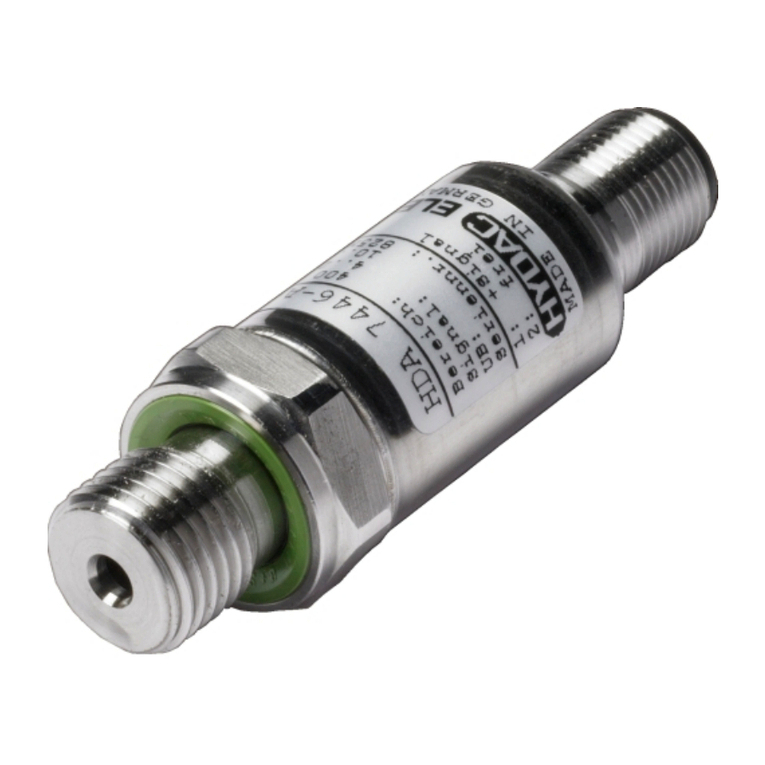
HYDACELECTRONIC
HYDACELECTRONIC HDA 7400 quick guide
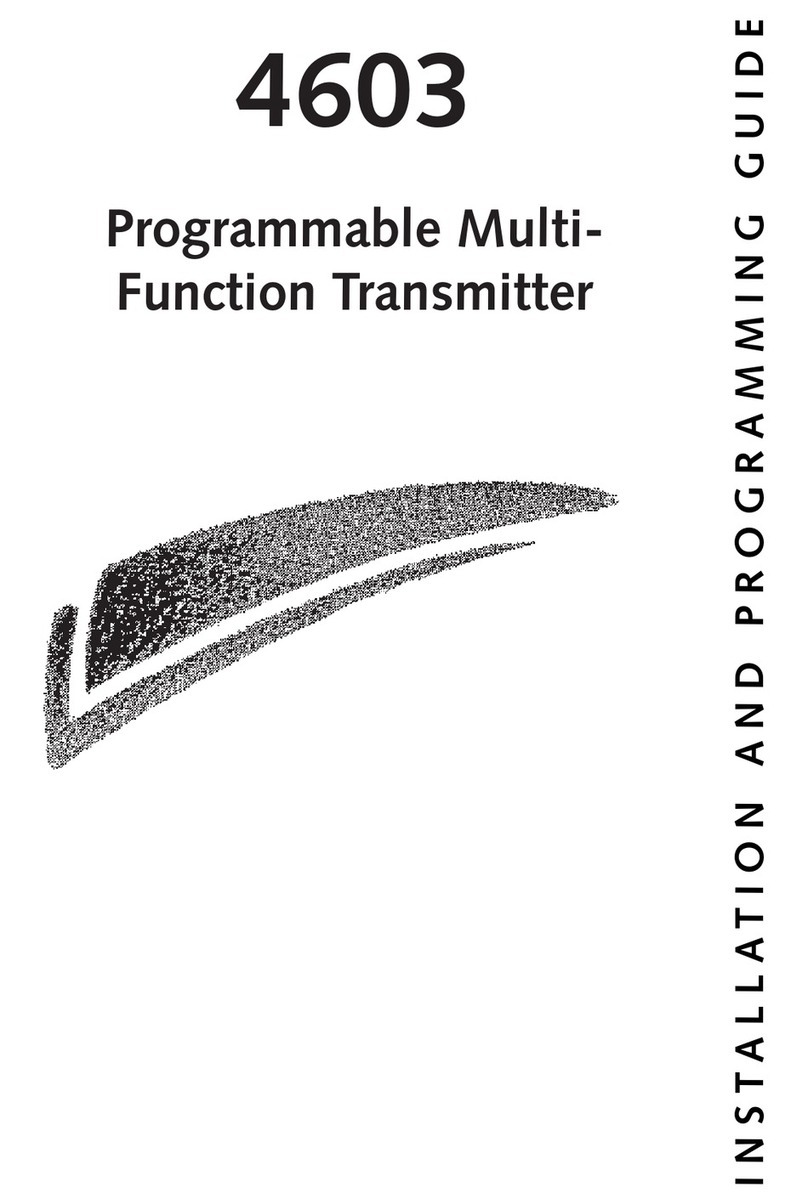
Scantronic
Scantronic 4603 Installation and programming guide
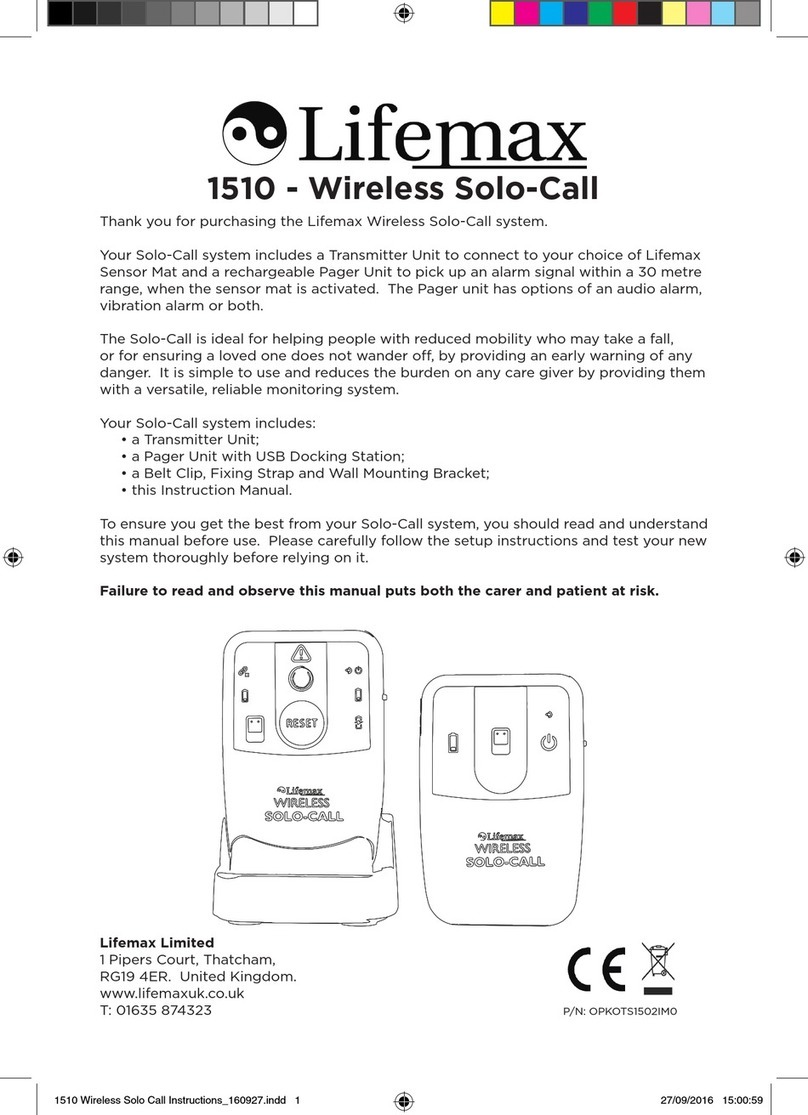
Lifemax
Lifemax Wireless Solo-Call manual
